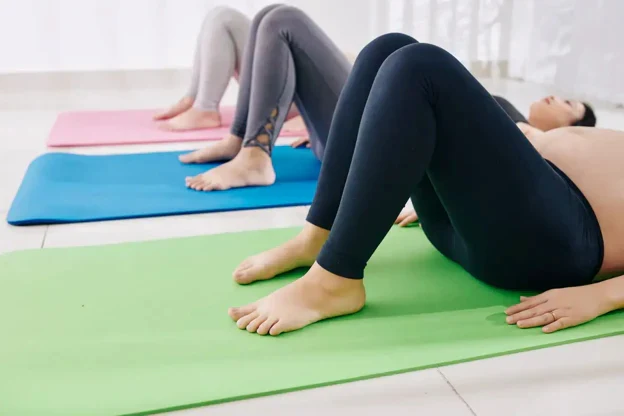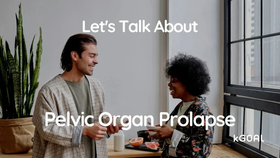The More You Know: 6 Common Pelvic Floor Myths
Published October 11, 2025

The pelvic floor is often seen as a magical and mythical place that people don’t learn about until there’s a problem with it (and often not even then!). Unfortunately, this leads to a number of misconceptions about what it actually is, what it does for the body, and how to best keep it healthy and doing its job.
To start with, check out our post Pelvic Floor 101, which is a great place to get started. Or, if you don’t want to bother with that (no judgment), just know that the important takeaway that helps frame THIS post is that problems with the pelvic floor (for women AND men) can include bladder issues like various forms of urinary incontinence or leakage, a number of forms of sexual dysfunction, constipation, and pelvic organ prolapse (that last one is just for women).
In this article, we want to tackle a few common misconceptions about your pelvic floor and hopefully help you to better understand this underappreciated, but super important, part of women's health (and men's health).
Myth #1: Pelvic floor problems are inevitable with age
Studies like this one have shown that 46% of women and 11% of men acknowledge some form of major pelvic floor dysfunction and that the prevalence of these issues increases substantially with age.
But, there’s a subtle but really important distinction here. It is common for people to experience challenges relating to their pelvic floor as they get older, but it is NOT normal or inevitable, and it shouldn’t be accepted as such. Most pelvic floor problems can be treated through preventative measures like a healthy lifestyle and good (pelvic floor) exercise habits, or therapeutic ones like physiotherapy or even occasionally surgery. The point is, even if you’re experiencing some challenges in your pelvic region that you didn’t experience when you were 18, don’t just accept it as the price of age or childbirth.
Furthermore, this myth is accompanied by the belief that pelvic floor problems are only common in “older” women (think 65+) and that they don’t affect younger or middle-aged people as much. This is also (definitely!) not the case (especially in the postpartum period).
This study analyzing the rate of occurrence of pelvic floor disorders in women aged 19-30 found that the overall rate of urinary incontinence in that age range was 10.3%. (It also found that the older women of the group had more awareness and understanding of pelvic floor disorders compared to the adolescents -- nice to confirm that with age comes some wisdom).
The study linked at the beginning of this section, with participants ranging from 15–97 years old, found that the overall prevalence of any type of urinary incontinence was above 35% for women. So, this is definitely not a “just for old people” issue.
Myth #2: Pelvic floor dysfunction only happens in women
While the symptoms or disorders may manifest differently, men are also susceptible to pelvic floor problems relating to both urinary and sexual function. (Unsurprisingly, the differences are most obvious on the sexual function side of things -- for instance, in men, pelvic floor-related sexual problems often manifest as erectile dysfunction or premature ejaculation, whereas in women they can be an issue related to vasodilation/swelling contributing to hypoactive sexual desire).
Women and men have mostly quite similar internal anatomy, and that also applies to the pelvic floor muscles. Pelvic floor exercises and therapy can benefit anyone and everyone. So, don’t let anyone fool you into believing that pelvic floor health isn’t for everyone.
Myth #3: Kegels are always the cure for pelvic floor problems
Kegel exercises have gotten some love in pop culture over the years (at least compared to other aspects of pelvic floor health), from mentions by Sex In The City a (horrifyingly large) number of years ago to Cardi B and Megan Thee Stallion just a few weeks before this was written in 2020. They also seem to have acquired a perception by some people as a kind of secret silver bullet that can get you anything from great orgasms to an end to pelvic pain.
The truth is that Kegels are a useful tool in the right situation. But the “right situation” is not “all situations”. There are many types of pelvic floor problems where Kegel exercise will be useless or even actively counterproductive.
The perception that Kegel exercise is the only weapon at your disposal if you’re having problems relating to your pelvic floor (by regular people and even sometimes by doctors) is both wrong and dangerous. A saw is a great tool if you’re trying to cut something. But if you’re trying to drill a hole, it’s probably not going to help you.
Myth #4: Kegel exercise is useless
The growth of Myth #3 has, unsurprisingly, led to a backlash against Kegels. It takes about 5 seconds to find someone online claiming that Kegel exercise is useless or even harmful. As is so often the case, the truth is in the middle. There is a wealth of published research showing the benefits of Kegel exercise in combatting or preventing many types of pelvic floor dysfunction. But as mentioned above, they are just one piece of the puzzle and are not always the right tool.
There are a lot of elements that go into pelvic health, from diet to exercise to other lifestyle factors, but Kegels shouldn’t be dismissed out of hand -- they can actually be highly beneficial.
Myth #5: You should stop the flow of urine to properly do Kegel exercise
Although this is a good way to find your pelvic floor muscles, it is not a good idea to do Kegels while you’re peeing. You could interfere with how your brain normally controls / connects with your bladder, which can be bad for your bladder and kidneys. You might also develop incontinence problems, hesitancy, or problems emptying the bladder.
Myth #6: All pelvic health concerns are related to weakness in the pelvic floor
This is closely related to Myth #3. Actually, if there’s a problem with your pelvic floor muscles, it usually goes in one of two opposite directions.
Some people have a hypotonic pelvic floor, which basically means weak pelvic floor muscles. Those with this type of pelvic floor can experience issues related to incontinence and pelvic organ prolapse, and this is the more commonly spoken about type of pelvic floor problem. This is a situation where exercises to increase pelvic floor muscle strength (aka Kegels) can often be helpful.
However, it is also not uncommon to have a hypertonic pelvic floor (this can also be called overactive or high tone), where the pelvic floor muscles are too tight. This type of pelvic floor issue often relates to urgency, frequency, constipation, and painful sex.
For your pelvic floor muscles to be at their best, they must be able to both contract and relax, just like any other muscle in your body. And recommendations if you need to strengthen your pelvic floor muscles are very different from recommendations if your pelvic floor is overactive.
The Bottom Line
We always loved those public service announcements in the 90s… “the more you know…”. Hopefully shining a light on some common pelvic floor myths will help people to be better equipped to optimize their own pelvic health. But as always, if you have pelvic floor issues or experience pelvic or back pain, it's never a bad idea to talk with a pelvic floor physical therapist to help determine the best approach (whether it's physical therapy or something else) to help your unique body maintain a healthy pelvic floor.












